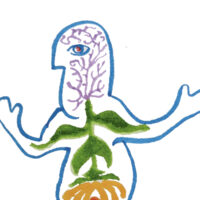How biodynamic preparations inoculate the soil.
As a result of climate change, we’re finding that drought, cold, poor soil structure, and nutrient deficiencies in the soil have become major challenges (growth stress) for plants. The microbiome in the soil plays an important role in strengthening plants. The diversity of bacteria and fungi in the soil is particularly relevant. In conventional agriculture, there are attempts to inoculate the soil with certain bacteria and fungi that are beneficial for plant growth, known as plant growth-promoting microbes (PGPMs). If only one bacterial strain is used for this, the effect is rather small. On the other hand, there is a greater effect if the soil is inoculated with a mixture of several bacterial strains. The origin also makes a difference: bacterial strains grown in the laboratory are less effective than those obtained from nature, it seems, because the latter are better adapted. So, it would be ideal to use a large number of bacterial and fungal strains from nature and to reproduce them in nature, not in the laboratory, as is usually the case.
The biodynamic preparations meet these requirements. Our experimental question was, therefore: Do the biodynamic preparations inoculate the soil with growth-promoting microorganisms (PGPMs)? Fourteen different biodynamic spray preparations were examined, all of which were found to have high levels of potential PGPMs. Do the high levels of PGPM in the preparations lead to more PGPMs in the soil after treatment? Our field trial in Frankenhausen showed that the values of potential PGPMs (Be Crop Index) with the application of the biodynamic preparations were significantly higher in most categories of phytohormones and stress adaptation than without the applications.
At 21 locations in France, the potential PGPMs with the application of the biodynamic spray preparations were also significantly higher than without the applications. Field trials in Darmstadt led to the same conclusion. Here, too, more frequent use of the spray preparations led to significantly higher values of potential PGPM compared to single applications. At one test site, the PGPM values were lower with the application of the preparations than without the application. Even if these differences were not significant, the result is relevant and interesting. This site remains an exception compared to the other 23. Only in two categories of PGPM, salicylic acid, and abscisic acid, was the proportion in the preparations very low. These were also the only two categories in which no significant increases in PGPM values were found in the field trials.
What Can We Learn From This?
These studies deepen our understanding of biodynamic preparations. In some trials, the effect of the preparations was very clear, in others the effect was small. This phenomenon is also known in inoculating the soil with PGPMs. The reason for this is thought to be the many factors and niches in the soil that play a role in successful colonization. It remains to be investigated why the preparations are obviously highly effective. Compared to inoculation experiments with bacteria and fungi from the laboratory, much smaller quantities are used in the biodynamic preparations. We know that plants can strengthen bacteria and fungi in the root area that are beneficial to them. The preparations may be an offering of PGPM to the plants, which they selectively strengthen. Stirring the preparations may activate the bacteria and thus make the effect more impactful. Thirdly, the consistency of the preparations offers a kind of biofilm in which the PGPMs are better protected. This raises new questions about the effect of the preparations. To research the intensification in the root area, we can compare samples before and after burying. To examine the reaction of the plant in the root area, we can compare samples taken from the entire soil and from the root area. To examine the activity of the bacteria, we can take samples before and after stirring. This can gradually lead to a better understanding of the effect of the preparations. Of course, this only describes one level of how biodynamic preparations can work. But the fact that we see effectiveness at this level makes its effect more understandable.
We draw the following conclusion: The microbiome in the soil is a mirror of its environment. As far as we understand, preparations offer the plant a diversity that helps it to better realize itself under growth stress.
This is a shortened and lightly edited version of the talk given at the conference.
See Milke et al. 2024: Enrichment of putative plant growth promoting microorganisms in biodynamic compared with organic agriculture soils. ISME Com.
More Natural Science Section: Evolving Science 2024
Translation Laura Liska
Image Jürgen Fritz during his presentation. Photo: Johannes Kühl









